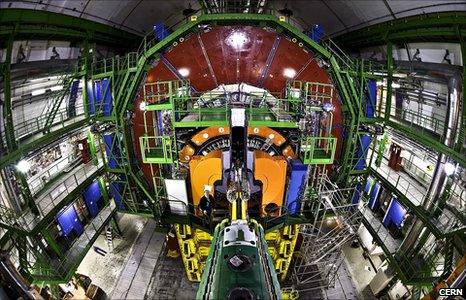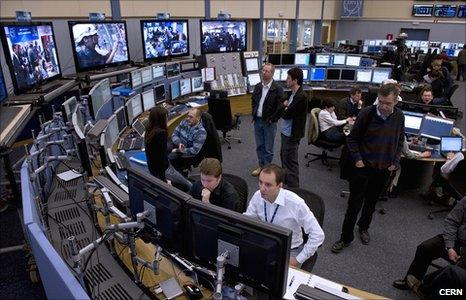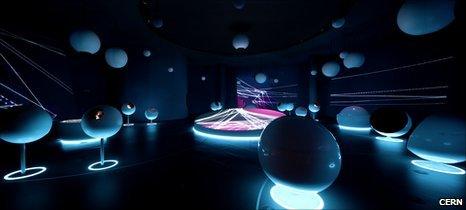LHC smashes beam collision record
- Published

The CMS experiment will search for signs of new physics in collisions at the LHC
Scientists working on the Large Hadron Collider (LHC) say they have moved a step closer to their aim of unlocking the mysteries of the Universe.
The world's highest-energy particle accelerator has produced a record-breaking particle collision rate - about double the previous rate.
The collider is now generating around 10,000 particle collisions per second, according to physicist Andrei Golutvin.
The LHC is housed in a 27km circular tunnel under the French-Swiss border.
The vast machine is operated by the European Organization for Nuclear Research (Cern), based near Geneva in Switzerland.
Physicists say this marks the start of turning the LHC into the world's most powerful particle collider.
"It's clear that the LHC is the new boy in town, but in two years running we're going to put Fermilab out of business," operation group leader Mike Lamont told BBC News.
The Tevatron particle accelerator at the Fermi National Accelerator Laboratory (Fermilab) in Illinois, USA, is the LHC's rival. It has operated at higher intensities, but the current collision rate is a record for Cern.
The LHC is expected to overtake the American machine in due course.
Over the past few months, LHC engineers have slowly and carefully increased the energy and intensity of the proton beams which race around the collider's 27km-long "ring".

The LHC will aim to detect the elusive Higgs boson
This weekend, engineers smashed together two beams consisting of three "bunches" of protons particles.
For the first time, these bunches were at "nominal" intensity - the intensity the LHC was designed to work at. This means each bunch consisted of as many as 100 billion protons.
The LHC smashed together its first two particle beams travelling at close to the speed of light in November 2009.
At the moment, it is running at half the energy it was designed for, but the scientists aim to take the machine to the top energy of seven tera-electronvolts (TeV) per beam by 2013.
Stationed around the collider's ring are four large experiments designed to study new physics - in a bid to shed light on the secrets of our Universe. These are Compact Muon Solenoid (CMS), Atlas, Alice and LHCb, of which Dr Golutvin is chief scientist.
Scientists hope to find an elusive sub-atomic particle known as the Higgs boson, dubbed the "God particle", which explained why matter has mass.
Nerve centre
Standing in the LHC's main control room, the machine's "nerve centre", Mike Lamont explained that his team has recently achieved a record luminosity - a measure of the number of protons colliding per second.
Luminosity is key to a particle smasher's power, he said. More collisions means more chances of "really interesting physics, like [finding] the Higgs", Dr Lamont explained.
Dr John Ellis, one of Cern's top theoretical physicists, is among those on the hunt for the Higgs. Dr Ellis said he was very excited by the LHC's latest record.
"Protons are complicated particles, they've got quarks, [and other small particles], and colliding them is like colliding two garbage cans and watching carrots come out," he told BBC News.
"The more collisions we get, the closer we get to supersymmetry, dark matter, the Higgs boson and other types of new physics."

The LHC main control room is based in Geneva
The theoretical physicist explained that collision rates depend on the bunch intensity - the number of protons in a bunch.
"Now we will be trying to increase the number of those bunches, and then probably in August we will spend quite a period of time just banging away and trying to get as many collisions as we can."
The eventual aim is to reach 2,808 bunches in a beam. The LHC team hopes to get there by 2016.
Professor Ellis added that as the luminosity increases, one of the things physicists at Cern will be looking for is a mini- black hole.
"It would be absolutely, fantastically exciting if we produced black holes at the LHC," he said.
"Then we would test our ideas about gravity, quantum physics, string theory. This would be much more exciting than finding a... Higgs boson or even dark matter."
A Cern report released in 2008 concluded that these mini-black holes would pose no danger, as they would vanish shortly after being made.
Scientists point out that the collisions generated by the cosmic rays which have been hitting the Earth's atmosphere from space for billions of years can be far more energetic than those at the LHC.
Beam stability
Dr Lamont said that before stepping up the bunch intensity, scientists had to be certain the beam carrying bunches at nominal intensity was not going to become unstable.
"Up to now we've been working with very low intensities because we didn't want to risk any damage," he said.
On March 30, the two beams that produced the first high-energy collisions of seven teraelectronvolts (TeV) contained four bunches each, but with a relatively small number of protons in each bunch.
He said that as the number of protons increased, the team had to be really careful not to lose "a high-intensity beam in an uncontrolled way".

Visitors to Cern can see a futuristic exhibition on particle physics
"The beam has got enough energy to melt a hole in the vacuum pipe, cause a vacuum leak into the magnet and helium leak into the vacuum pipe. It could be a real mess and would probably take us six months to repair," said Dr Lamont.
But he said the consequences for the general public would be roughly nil.
"Standard analogy is a British aircraft carrier going at 12 knots. Imagine it going into the Mont Blanc Bridge - it would be a real wreck, but it would not destroy half of Geneva.
"And given that this is all buried 100m under ground, the loss of energy would be very localised and safely contained in the tunnel."
A helium leak happened once before - in 2008. Shortly after the collider was first switched on, a fault with an interconnection between two magnets caused six tonnes of liquid helium to leak into the tunnel.
It took the scientists 14 months of repairs to re-launch the machine.
The LHC is located in a picturesque region of French-Swiss Alps, but Dr Lamont said the team has so far had few opportunities to get off the site and enjoy the area's natural beauty.
"The aim over this summer now is to get into a routine, where we're just turning the handle, delivering collisions on a regular basis to the experiments," he said.
And this weekend's record is the first step towards that goal, he added.
"Once we get into a routine, [scientists on individual experiments] can get on with their analysis, and we can gradually increase the intensity and at the same time catch our breath, go home see our families and maybe get into the mountains occasionally."